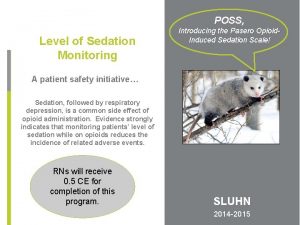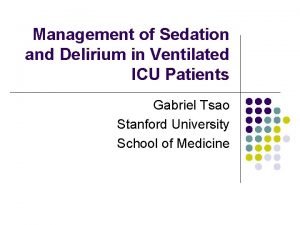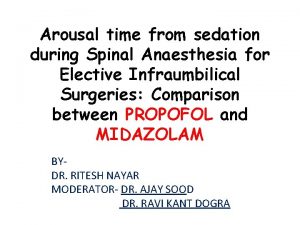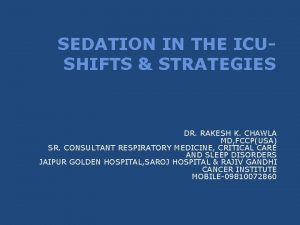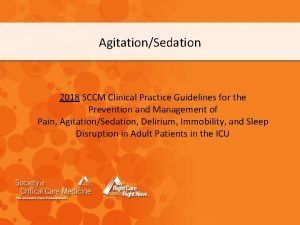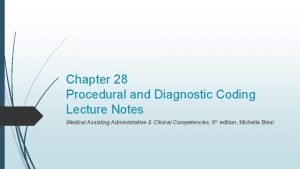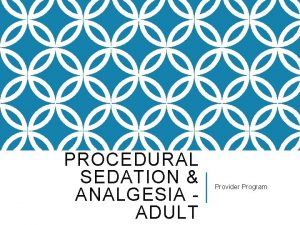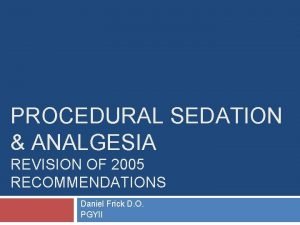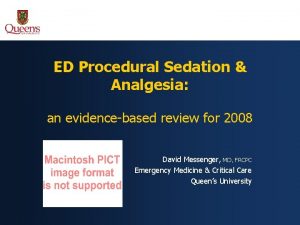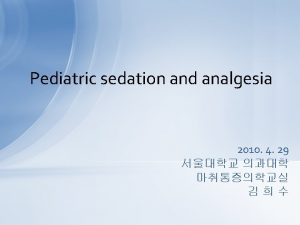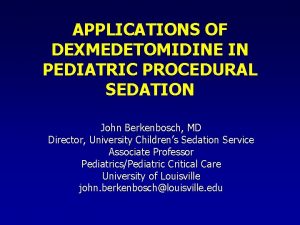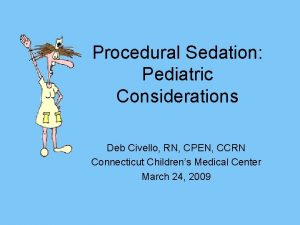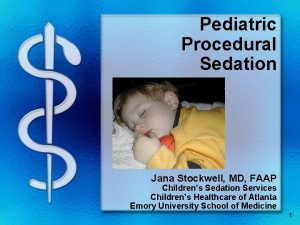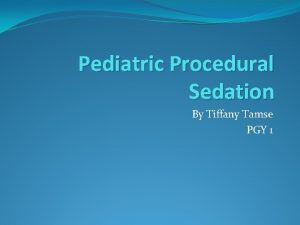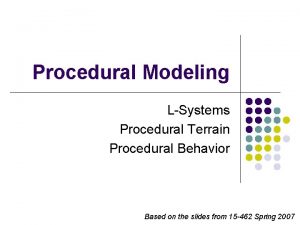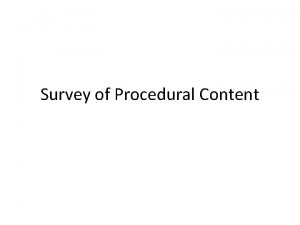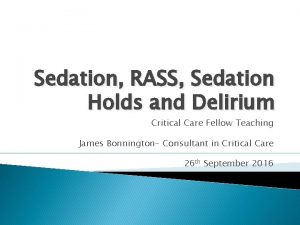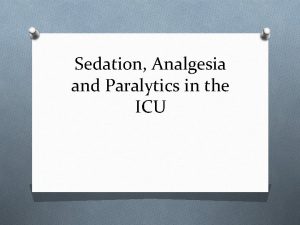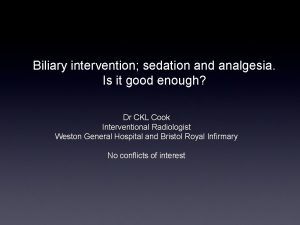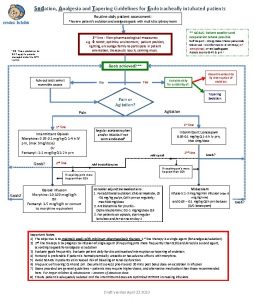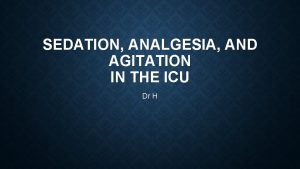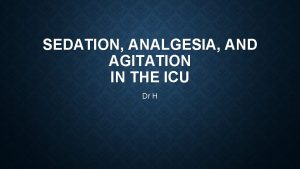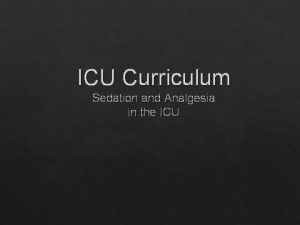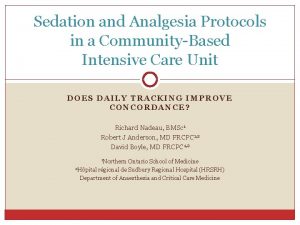Procedural Sedation and Analgesia The Pediatric Patient Pediatric






















































- Slides: 54

Procedural Sedation and Analgesia The Pediatric Patient

Pediatric Procedural Sedation Course Content § § § SNHMC policy and guidelines Regulatory requirements Pre-procedure planning Conduct of pediatric sedation Pharmacology of sedative agents Patient safety & outcomes

Pediatric Procedural Sedation § Who are the interested parties involved in credentialing pediatric moderate sedation? § Regulatory bodies § NIAHO-DNV-GL § The Joint Commission § Centers for Medicare and Medicaid (CMS) § Institutional policy § Academic framework § American Society of Anesthesiologists § American Academy of Pediatrics

Pediatric Moderate Sedation § What is expected from the credentialing process for moderate sedation privileges? § Leadership from anesthesiologists § Uniform processes / consistent standards of care, regardless of: § § Patient age Procedure Location Provider § Effective & reliable system of rescue § Institutional sedation safety and efficacy

SNHMC Procedural Sedation Policy Covers the following information: § Key definitions: § Moderate Sedation § Core competencies for providers § specialized knowledge in procedural sedation for pediatric population § experiential components: airway management demonstration or current certification in recognized life support program (PALS) § Procedural requirements for providers § Airway assessment, ASA risk assignment, patient assessment, administration of medications, monitoring, recovery, & discharge

Goals and Objectives • Goals of Procedural Sedation: • Enhanced patient cooperation • Decreased patient movement • If the procedure requires that the patient does not move at all, consider an anesthesia consult as procedural sedation does not provide for this • • • Amnesia (not guaranteed) Rapid recovery Maintain adequate sedation with minimal risk Relieve anxiety Provide relief from pain and other noxious stimuli

What is the intent of procedural sedation? § § § Reduction of fear, anxiety, & stress Provision of comfort, safety, and a sense of well-being Cooperation during procedure to allow its completion Alteration of memory or amnesia Provision of pain control

The Myth of Moderate Sedation MYTH: • Complete immobility/absence of pain can be achieved False: • To meet that request, you need: • Deep sedation • Anesthesia

Consider the following: In the pediatric population: To meet necessary goals, sedation/analgesia usually must be deeper than given to adults. Due to physiologic differences, children are at higher risk for respiratory depression and lifethreatening hypoxia. Technically, “moderate sedation” may be closer to the definition of “deep sedation” because children can easily slip from one level to another.

Continuum of Sedation: Consider: it is easy for a child to slip from one level to the next despite the original plan and intent anxiolysis Moderate Sedation Potential loss of airway Protective reflexes Deep Sedation General Anesthesia Respiratory depression CV collapse

What is expected of the provider vis-à-vis procedural sedation? § During the administration of sedatives it expected that the provider: § be physically present with the patient § be aware of the patient responses as they monitored by the nurse during the administration of the medications and during the procedure

What is expected of the provider during procedural sedation? § You must remain “immediately available”, that is you cannot leave the area or be engaged in any other un-interruptable activity or task § You must know how to § Rescue from over-sedation § support the airway with BVM ventilation § stabilize hemodynamics

Documentation Responsibilities: Provider § Informed consent for sedation § History and Physical completed in chart § Pre-sedation assessment § Includes ASA assignment and airway classification § § § Time-out signed Medication orders signed “special procedures” note complete Verify recovery/discharge criteria met Officially discharge patient from moderate sedation

Patient Considerations

Patient Considerations § Current Medications? § Drug allergies? § Results of diagnostic tests / labs? § LMP? pregnant? § Prior response to sedatives or anesthetic agents?

Patient Considerations Chronologic and developmental age Baseline level of responsiveness Baseline vital signs Anxiety / cooperativeness of patient Focused physical exam Risk for loss of protective reflexes, airway obstruction, cardiopulmonary or neurologic decompensation • Patient Considerations § § §

Does the child have medical issues that could put him or her at increased risk for complications? • Recent upper respiratory illness symptoms, especially coughing, wheezing, or nasal congestion, can increase the risk of airway irritability and respiratory complications, including hypoventilation, desaturation, and laryngospasm. • Similarly, a history of recent vomiting or symptomatic gastroesophageal reflux can be cause for concern, as emesis during sedation, when airway protective reflexes may be blunted, could lead to aspiration and initiate laryngospasm. • Significant obesity, an increasing problem in the pediatric population, may be associated with an increased risk of airway obstruction, especially with deeper levels of sedation. • Overt obstructive sleep apnea symptoms are clearly associated with airway obstruction during sedation; however, many families are unable to say how frequently or how badly their children snore. Even occasional audible snoring makes the need for airway repositioning and nasopharyngeal airway placement more likely

Pediatric Medical Problems • Developmentally delayed patients frequently have a less predictable response to effects of sedation/analgesia • Hypertrophied tonsils/adenoids increase risk of airway obstruction while sleeping • Elective cases should be postponed if any of the following are present: • Croupy cough • Significant temperature • Significant sign of URI • Malaise/decreased appetite • Evidence recent lower resp infections (rales, wheezes, productive cough)

Patient Considerations: What’s crucial in the airway evaluation? § known difficulty § mouth opening § nares patent § tongue size and mobility § neck mobility, especially in extension § recessed chin or micrognathia § cranio-facial anomalies § airway malacias § adeno-tonsillar hypertrophy § obesity § Obstructive sleep apnea § Note: many syndromes have airway issues

Mallampati Airway Assessment • Mallampati airway classification predicts high risk or difficult airways (Class III or IV warrant consultation with an anesthesiologist)

ASA Physical Status Classification System § PS 1 - normal healthy patient § PS 2 - patient with mild systemic disease, no functional limits § PS 3 - patient with severe systemic disease, some functional limits § PS 4 - patient with severe systemic disease that is a constant threat to life § PS 5 - patient not expected to survive for 24 hours with or without the procedure § These definitions appear in each annual edition of the ASA Relative Value Guide. ® There is no additional information that will help you further define these categories.

NPO Guidelines • Although the need for strict NPO guidelines for urgent and emergent sedations continues to be a topic of debate, most physicians should plan to adhere to the recommended ASA guidelines. These suggest the following NPO times: • Clear liquids—two hours • Breast milk—four hours • Infant formula, other nonhuman milk, solids—six hours • Full meal—eight hours

NPO Guidelines • *For children requiring sedation who do not meet the ASA NPO guidelines, recommended options include delaying the procedure or consulting anesthesia *urgency of the situation is considered

What leads to sedation problems? • • • Combinations of meds Poor patient selection Incorrect drug dosing Lack of appreciation of drug interactions Lack of or inadequate monitoring before, during and after sedation

Procedure-Related Considerations

Procedure Related Considerations First, determine your needs: Sedation? Analgesia? Anxiolysis? Immobility? Amnesia? ALL of these?

Planning Procedural Sedation in Pediatric Population • When planning sedation and/or pain management for a child, knowing what level of responsiveness needs to be achieved during the procedure or test is essential for choosing the appropriate medication regimen. • Painful procedures that require relative immobility generally mandate a deeper level of sedation than noninvasive radiological tests. • Each sedation plan should take into account the age, developmental level, and personality of the child.

Monitoring the sedated child Continuously monitored parameters § Adequacy of ventilation / oxygenation § Hemodynamic stability § Level of consciousness / responsiveness

Monitoring ventilation and oxygenation Ongoing assessment for adequacy of ventilation and oxygenation includes § Airway patency § Rate, depth, & pattern of ventilation § Oxygenation through pulse oximetry § Ventilation via observation of chest rise, rate and ETCO 2 monitoring

Monitoring the sedated patient § Recognizing airway obstruction: § Snoring § Falling O 2 sats § Retractions § Laryngospasm § Scary silence or Deadly Quiet § Absent or exhaled CO 2 § Relieving airway obstruction: § “Sniffing” position § Shoulder roll § Jaw lift § Nasal airway § Consider need to reverse § Consider need to call anesthesia for assistance

Monitoring the sedated patient Hemodynamic stability: § heart rate § non-invasive blood pressure § electrocardiography (EKG)- 3 lead monitoring

Monitoring the sedated patient Level of consciousness (LOC) § responds to verbal command? § responds to tactile stimulus? § protective reflexes intact? § pain assessment (as appropriate) *reflex withdrawal to pain is not considered a purposeful response

We use the Riker Sedation Scale for LOC assessment:

Personnel Considerations

Personnel Considerations § Level of experience for this procedure § Availability of staff & equipment for: § patient transport § administration of sedation & monitoring § rescue / resuscitation § recovery

Personnel Requirements: Support personnel: q. At least 1 person dedicated to the patient to constantly monitor appropriate physiologic parameters and assist in any supportive or resuscitation measures q. Be trained in, and capable of providing, pediatric basic life support q. Know how to use resuscitation equipment & supplies in the event of an emergency

Strategies for successful sedation practice in pediatrics § Outcomes improve when services are provided by dedicated, appropriately configured, and experienced teams using clear guidelines / protocols

Strategies for successful sedation practice in pediatrics Choose single-agent regimens for non-painful, non-invasive imaging studies, and reserve combination regimens for procedures which require both analgesia and sedation.

Strategies for successful sedation practice in pediatrics CONSIDER RISKS: combining sedative / hypnotics or general anesthetics with opioids significantly increases the risk for: loss of airway hypoventilation hypoxia bradycardia

Strategies for successful sedation practice in pediatrics Non-pharmacologic techniques can reduce the need for extreme doses of drugs: § guided imagery § music / distraction / videos in MRI § relaxation techniques § parental presence § calm atmosphere and personnel

Strategies for successful sedation practice in pediatrics § Titrate frequent, appropriate doses at appropriate intervals when using potent intravenous sedatives and analgesics. § Be patient and give agents time to work! § Reduce initial doses when combining agents of different classes.

Commonly Used Medications

Medications • Benzodiazepines • Versed/midazolam • Sedative/anxiolytic/amnesic • Paradoxical reactions (1 -2% of population may experience this) • • Inconsolable crying Combativeness Disorientation Dysphoria Tachycardia Agitation restlessness

Medications • The following medication information is taken directly from SNHMC’s Policy and Procedure manual. • It is the responsibility of the ordering provider to individualize the dosing and timing of medications to meet the patient’s needs. • It is the responsibility of the provider ordering the medications to be familiar with their actions, indications, method of administration, contraindications, precautions, adverse reactions and management of the drugs’ complications.

Medication Midazolam IV (Versed) Class Benzodiazepine Anesthetic Adjunct Initial Dose 6 months-5 years 0. 05 - 0. 1 mg/kg 6 years- 11 years 0. 025 - 0. 05 mg/kg 12 years-18 years 0. 5 – 2 mg each dose Midazolam PO (Versed) 6 months-5 years 0. 5 - 1 mg / kg 6 years- 15 years 0. 25 -0. 5 mg /kg Repeat Dose Techniques of Administration May repeat specific dose every 5 Give: each dose slowly over 2 minutes (Onset 3 -5 minutes per pediatric procedural minutes). Subsequent doses in age appropriate sedation order set if Riker’s Scale increments. score=5 to MAX of 6 mg Wait: an additional 5 or more minutes after each May repeat specific dose every 5 increment to fully evaluate the sedative effect minutes per pediatric procedural sedation order set if Riker’s Scale score=5 to MAX of 10 mg Repeat: Titrate with age appropriate doses to the appropriate level of sedation May repeat specific dose every 5 Total doses: see maximum doses by age minutes per pediatric procedural sedation order set if Riker’s Scale Duration: 1 -5 hours in healthy patient score=5 to MAX of 10 mg Warnings: When given in conjunction with opioids or other sedatives, the potential for respiratory depression, airway obstruction, or hypoventilation is increased Usually do not repeat Give: one dose 30 minutes prior to procedure Wait: Usual Onset 10 – 20 minutes

Medication Flumazenil (Romazicon) Class Benzodiazepine Antagonist Initial Dose 1. mg/kg Each dose not to exceed 0. 2 mg Techniques of Administration Give: each dose over 15 seconds Wait: 45 – 60 seconds after each dose to fully evaluate the reversal effect Repeat: Push dose over 15 seconds. Repeat the same dose every 1 minute as needed to max dose of 0. 05 mg/kg or 1 mg, whichever is lower. Total doses: > 1 mg usually not necessary for reversal of over-sedation Duration: half life of flumazenil is about 40 minutes, duration of activity depends on how much of the sedating benzodiazepine remains in plasma Warnings: Excessive reversal with flumazenil may result in anxiety or seizures in predisposed patients Reversal must not be substituted for an adequate period of post-procedure monitoring Naloxone IV (Narcan) Class Opioid Antagonist Toxicology-Antidote Agent NON ARREST Give: each dose slowly over 30 seconds Wait: 2 minutes after each dose to fully evaluate the reversal effect 1. mg / kg Repeat: Titrate with weight based dose to the appropriate level of sedation / reversal each dose not to exceed 0. 2 mg Excessive reversal with naloxone may result in total reversal of analgesia with additional side effects ARREST- Less than (hypertension, excitation) 20 kg, give 0. 1 mg/kg - Greater than or equal to 20 kg Total doses: > 1 mg usually not necessary for reversal of over sedation OR Greater than 5 years give Duration Short duration of naloxone may require repeat dosing to manage re-sedation with certain 2 mg/dose longer acting opioids

Reversal • Manage symptoms first, if patient not responding in the anticipated manner then move to reversal • Consider • Is procedure complete? • Which drug is causing the issue? Not always clear but should not administer both reversal agents • Consider reversing the drug that has been given in the higher dose unless it is clear which drug is causing the adverse reaction • Reversals have side effects • 2 hour observation time of the patient post-reversal dosing is mandatory

Of note… • The medication guidelines may not be appropriate for use in all circumstances. Decisions to adopt any particular recommendation must be made by the practitioner in light of available resources and circumstances presented by individual patients. • References: Package Information, flumazenil, naloxone. Lexi-Comp Pediatric Dosage Handbook

Failed Sedation • Defined as medications continually titrated to little or no effect • Usually restless, combative, uncooperative • Presence of a URI, a history of OSA/snoring, ASA class III, obesity, and older age are associated with increased probability of failed sedation. * • Any patient “failing sedation” must be monitored closely for signs of delayed sedation before discharge • *Grunwell, Mc. Cracken, Fortenberry, Stockwell, & Kamat, 2014

Postsedation Recovery and Discharge Ongoing monitoring and observation are critical during recovery from procedural sedation and should continue until the child’s vital signs and level of interaction have returned to their pre-sedation baselines. Significant adverse events can occur during emergence, especially if medications with longer half lives were used. The recovery area should be equipped with the same monitoring and resuscitation equipment as the sedation and procedural area itself, and the same rescue resources should be available.

Postsedation Recovery and Discharge • Children should be discharged only when they have met specific pre-established recovery criteria and after the family has received detailed instructions for post-sedation care, including instructions about how to seek follow up medical care if it is needed.

Post-Sedation Care • CV function and airway patency should be stable and satisfactory Patient is: • Easily arousable with intact protective reflexes • Able to talk if age and intellect appropriate • Able to sit up if age and motor skills allow • Returned to pre-procedure baseline • Hydrated adequately

Post-Sedation • • The patient may be discharged to home when the discharge criteria have been met and sedation or narcotic analgesic has not been administered within 30 minutes. (EXCEPTION: Patient must be monitored for a minimum of two hours if a patient has required a rescue with a reversal agent. ). A discharge order must be written by the provider.

Summary • Anatomical and/or physiological variations associated with pediatric patients predisposes them to additional morbidity risks. • You must be familiar with medications, dosages, reversals utilized. • Regulatory bodies deem that providers responsible for providing procedural sedation must be clinically competent to handle all emergencies that may arise in pediatric sedation setting.
 Analgesia sistemica
Analgesia sistemica Scala di bromage
Scala di bromage Poss scale vs rass scale
Poss scale vs rass scale Rass sedation scale
Rass sedation scale Richmond agitation sedation scale
Richmond agitation sedation scale Over-sedation
Over-sedation Riker scale
Riker scale Sédation
Sédation Sccm pad guidelines
Sccm pad guidelines Patient 2 patient
Patient 2 patient Chapter 28 procedural and diagnostic coding
Chapter 28 procedural and diagnostic coding Compare procedural semantics and declarative semantics.
Compare procedural semantics and declarative semantics. Physical and procedural barriers of cross contamination
Physical and procedural barriers of cross contamination Hình ảnh bộ gõ cơ thể búng tay
Hình ảnh bộ gõ cơ thể búng tay Lp html
Lp html Bổ thể
Bổ thể Tỉ lệ cơ thể trẻ em
Tỉ lệ cơ thể trẻ em Chó sói
Chó sói Chụp phim tư thế worms-breton
Chụp phim tư thế worms-breton Chúa sống lại
Chúa sống lại Các môn thể thao bắt đầu bằng tiếng nhảy
Các môn thể thao bắt đầu bằng tiếng nhảy Thế nào là hệ số cao nhất
Thế nào là hệ số cao nhất Các châu lục và đại dương trên thế giới
Các châu lục và đại dương trên thế giới Cong thức tính động năng
Cong thức tính động năng Trời xanh đây là của chúng ta thể thơ
Trời xanh đây là của chúng ta thể thơ Cách giải mật thư tọa độ
Cách giải mật thư tọa độ Phép trừ bù
Phép trừ bù Phản ứng thế ankan
Phản ứng thế ankan Các châu lục và đại dương trên thế giới
Các châu lục và đại dương trên thế giới Thể thơ truyền thống
Thể thơ truyền thống Quá trình desamine hóa có thể tạo ra
Quá trình desamine hóa có thể tạo ra Một số thể thơ truyền thống
Một số thể thơ truyền thống Cái miệng nó xinh thế chỉ nói điều hay thôi
Cái miệng nó xinh thế chỉ nói điều hay thôi Vẽ hình chiếu vuông góc của vật thể sau
Vẽ hình chiếu vuông góc của vật thể sau Biện pháp chống mỏi cơ
Biện pháp chống mỏi cơ đặc điểm cơ thể của người tối cổ
đặc điểm cơ thể của người tối cổ Ví dụ về giọng cùng tên
Ví dụ về giọng cùng tên Vẽ hình chiếu đứng bằng cạnh của vật thể
Vẽ hình chiếu đứng bằng cạnh của vật thể Fecboak
Fecboak Thẻ vin
Thẻ vin đại từ thay thế
đại từ thay thế điện thế nghỉ
điện thế nghỉ Tư thế ngồi viết
Tư thế ngồi viết Diễn thế sinh thái là
Diễn thế sinh thái là Các loại đột biến cấu trúc nhiễm sắc thể
Các loại đột biến cấu trúc nhiễm sắc thể Các số nguyên tố là gì
Các số nguyên tố là gì Tư thế ngồi viết
Tư thế ngồi viết Lời thề hippocrates
Lời thề hippocrates Thiếu nhi thế giới liên hoan
Thiếu nhi thế giới liên hoan ưu thế lai là gì
ưu thế lai là gì Hổ đẻ mỗi lứa mấy con
Hổ đẻ mỗi lứa mấy con Sự nuôi và dạy con của hươu
Sự nuôi và dạy con của hươu Hệ hô hấp
Hệ hô hấp Từ ngữ thể hiện lòng nhân hậu
Từ ngữ thể hiện lòng nhân hậu Thế nào là mạng điện lắp đặt kiểu nổi
Thế nào là mạng điện lắp đặt kiểu nổi


